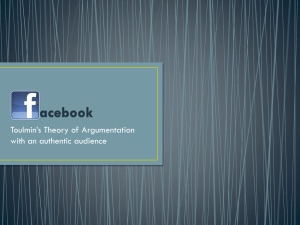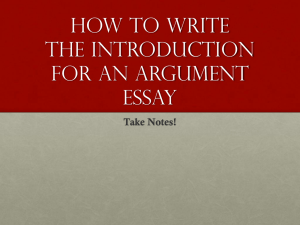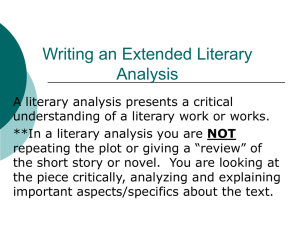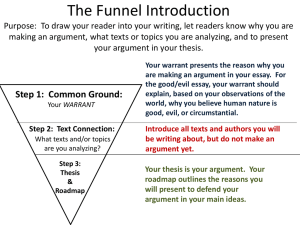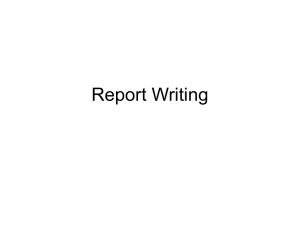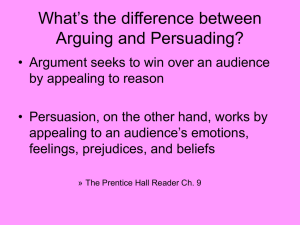mastering the art of argument through collaboration and
advertisement
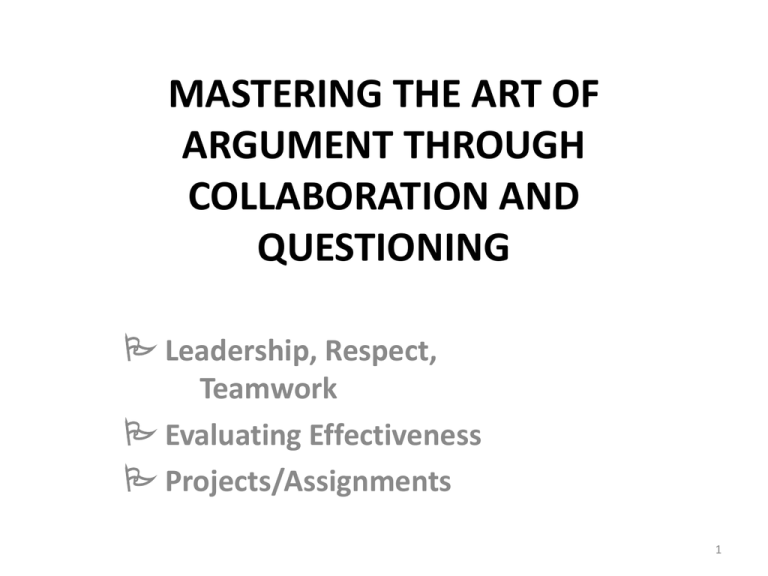
MASTERING THE ART OF ARGUMENT THROUGH COLLABORATION AND QUESTIONING Leadership, Respect, Teamwork Evaluating Effectiveness Projects/Assignments 1 Goals for the Presentation • • • • • • • • • • • • • • Common Core Standards and AP parallels Identify the characteristics of good groups and roles of group members and leader Demonstrate ways to evaluate group behaviors and outcomes Offer suggestions for forming argument questions Group work in presentations (Dialogue Skills) Sample lessons and activities Evaluating and assessing a group’s work (Reflection Skills) 2 COMMON CORE STANDARDS • From The Common Core Standards—Note on range and content of student speaking and listening: • “To become college and career ready, students must have ample opportunities to take part in a variety of rich, structured conversations—as part of a whole class, in small groups, and with a partner—built around important content in various domains. They must be able to contribute appropriately to these conversations, to make comparisons and contrasts, and to analyze and synthesize a multitude of ideas in accordance with the standards of evidence appropriate to a particular discipline. Whatever their intended major or profession, high school graduates will depend heavily on their ability to listen attentively to others so that they are able to build on others’ meritorious ideas while expressing their own clearly and persuasively.” • 3 Chief Reader’s Remarks • David Jolliffe, Chief Reader of Advanced Placement English Language and Composition, says: “Students must learn to understand, acknowledge, and respect opposing opinions.” • To do this, students must learn reasoned discourse. To learn this, they may need to learn how to engage in argumentation with others in a more productive way before they, as individuals, can reap the potential benefits of collaboration. They need to have opportunities to bounce ideas off others, to listen to other viewpoints, and to think about a problem in new ways in a more deliberative manner. This, I think, comes from the conflict stimulated by group discussion. They learn how to look for mutual knowledge and common ground. Most importantly, they are exposed to alternative ways of thinking about a problem or issue facing society today. 4 Research Shows: • In a study done by Victor Sampson of Florida State University and Douglas Clark of Arizona State University, their research shows that the effects of collaboration on argument quality and individual learning are the most valuable skills as student can master. • These are all tasks that require students to produce an argument that articulates and justifies a particular point of view of an issue that they as a group determine. Fostering productive argumentation requires students to propose, support, critique, and refine ideas. • Opportunities to collaborate with others can lead to more productive argumentation and improved learning outcomes because groups can pool knowledge and take advantage of different cognitive or monitoring resources. • 5 Collaboration & Common Core • Common Core Standards covered by this methodology: (All are Standards for grades 11-12) • • • • • Writing: • • • College and Career Readiness Standards Comprehension and Collaboration 1, 2, & 3 Presentation of Knowledge and Ideas 4, 5, & 6 • • • • • • • • • • Speaking and Listening Comprehension and Collaboration 1a, b, c, d Comprehension and Collaboration 2 & 3 Presentation of Knowledge and Ideas 4, 5, & 6 Writing Standard 1a, b, c, d, e Writing Standard 6—Production and Distribution of Writing Writing Standards 7 & 8—Research to Build and Present Knowledge Writing Standard 10—Range of Writing Standards can be found at this website: http://www.corestandards.org/assets/CCSSI_ELA%20Standards.pdf 6 AP Argument Prompts • "Contemporary life is marked by controversy. Choose a local, national, or global controversy with which you are familiar. Then write an essay in which you characterize the opposing positions and offer a compromise or a solution." • Write an essay in which you evaluate the pros and cons of Singer’s argument. Use appropriate evidence as you examine each side, and indicate which position you find more persuasive. • • • • “. . . whatever money you’re spending on luxuries, not necessities, should be given away.” The solution to world poverty would be for people in developed countries to send all the money they don't spend on necessities to organizations like Oxfam and Unicef. Students are directed to weigh carefully the pros and cons of Singer's position and then argue which side they thought was the better. • 7 Group Roles (Leadership Skills) • • • • • • • • • • • • • • • • • • • • A. Facilitator’s Role Play a neutral role Get everyone involved Prevent a group member from dominating Keep group on task (no birdwalking) Encourage cohesiveness of the group Responsible for completing task within allotted time period. B. Recorder’s Role Clearly communicate audible ideas to facilitate visual learning Write legibly and large Use a variety of colors Record group’s ideas to be used later (for test, written assignment, or assigned activity) Group cannot correct spelling errors C. Group Member’s Role Participate Cooperate Generate ideas Be respectful of the ideas of others 8 Four Horsemen • A decision-making process used by successful leaders who want broad based decisionmaking • • Brainstorm • Clarify • Advocate • Prioritize • • Remember: “Suicide statements” and “murder statements” are not allowed under any circumstances. • 9 Group Behaviors • • • • • • • • • • • • • WORK BEHAVIORS 1. Has new ideas or suggestions 2. Asks for or gives information 3. Helps to explain better 4. Pulls ideas together 5. Finds out if the group is ready to decide what to do. 10 Helping Behaviors • • • • • • • 1. Gets people together 2. Brings other people in 3. Shows interest and kindness 4. Is willing to change own ideas if someone makes a good argument • • 5. Tells others in a good way how they are behaving. 11 TROUBLESOME BEHAVIORS • • • • • • • • • • • • • • • • 1. Attacks other people (“murder statements”) 2. Won’t go along with other people’s suggestions 3. Talks too much 4. Keeps people from discussing because he or she does not like arguments 5. Shows that he or she does not care about what is happening 6. Lets someone boss the group 7. Does not talk and contribute ideas 8. Tells stories and keeps the group from getting their work done (“birdwalking”). 12 CHARACTERISTIC BEHAVIORS OF PRODUCTIVE GROUPS • • • • • • • • • • • • • • • • • • • Members listen intently They say things clearly They are open to share They listen to and try out others’ ideas They ask for others’ impressions of them They contribute to the group’s awareness of itself They contribute to problem definition and identification They keep alert to ways in which they can support others in the group They act in the group by using a diagnostic approach They operate as full members of the group. • 13 Last Words on Civility • In Stephen Carter's book Civility: Manners, Morals, and the Etiquette of Democracy (New York: Harper Perennial, 1999), the noted Yale law professor outlines his ideas for rebuilding a civil and humane society. In a civil democratic society, Carter says, conversation and not legislation nor adjudication must be the preferred means of discussing and resolving differences. A few of his main points are pertinent to this discussion of discussions 14 Civility Our duty to be civil toward someone doesn't depend on whether we like the person or not. Civility doesn't require us to mask our differences but to express and resolve them respectfully. Civility requires that we listen to others with knowledge of the possibility that they may be right and we may be wrong. Civility requires a commitment to be trustworthy and generous in working not only for the success of self but for the success of the community. – --Tim Gillespie, Lake Oswego High School (used with permission) 15 REQUIREMENTS FOR ARGUMENT FORMATION AND PRESENTATION • Topics: Education, Work, Community, Gender, Ethics, Language, Leadership, Popular Culture, Environment, and Success • Questions: Write one question about each topic that you would like to argue for or against. • Education: • Work: • Community: • Gender: • Ethics: • Language: • Leadership: • Popular Culture: • Environment: • Success 16 • For each theme discuss the following items. Keep all information to share with the rest of the class. • Definitions • Pro • Con • Middle of the Road • Dangers/Trap Doors • Literary Evidence • Current Event Evidence • Personal Evidence • Most credible evidence/spokesperson • Least credible evidence/spokesperson • Your viewpoint • Why 17 • Non-fiction genres: essays, autobiographies and memoirs, biographies, newspaper columns, speeches, journals, letters, government documents, academic journal articles, editorials • Imaginative Literature: short stories, novels, plays, poetry • Meet with your group members decide on ONE question for each category and then turn in one paper that tells which topic your group would like to research, argue, and present to the class. Give me first choice, second choice, third choice, and None of Us Want This One! I will try my best to give you your first or second choice 18 GROUP ROLE Statement of Candidacy • • • • • • • • • • • • • • • • • • My name is This is my major strength: (I can do this well) This is my major weakness: (I cannot. . .) A major problem to overcome with this project: (I will never be able to. . .) Any extra assets available that I have access to I want to be selected as the leader because Choosing the Leader- - - - - - - - - - - - - - - - - - - - - - - - - - - - - - - - - - - - - - - - - - - - - - - - - - - - - 1. Team Member’s Name and summary 2. Team Member’s Name and summary 3. Team Member’s Name and summary 4. We have decided that the leader of our group will be. . . 5. The group leader was chosen because. . . 6. We would like to present this section of the book: First Choice Second Choice Third Choice We’ll take it, but we won’t like it. . . Group Leader: Collect all papers, staple yours to the top; turn in to basket in front . 19 SCORING GUIDE: Leaders Group Performance • • • • • • • • • • • • • • • At the end of each presentation, each student in class will fill out an evaluation sheet on how well the group did and how many points are deserved based on the 50-point rubric below. During the preparation of your presentation, you should be aware that your group will be graded on the following criteria: Grade F—Minimal achievement (up to 10 points) Exclusive reliance on one spokesperson Little interaction (no teamwork is evident) Very brief conversations Some members are disinterested or distracted All members are reading from prepared material Grade D—Basic Achievement (from 11 - 20 points) Strong reliance on spokespersons Only one or two persons actively participate Occasional interaction Presentation not entirely centered on topic Some members are reading from prepared material 20 • • • • • • • • • • • • • • • • • • • • • • • • Grade C—Commendable achievement (from 21 - 30 points) Some appearance of interaction At least half of the students are prepared and familiar with information Attentive participation and involvement Some evidence of discussion of topic Only one member is reading from prepared material Grade B—Superior Achievement (from 31 - 40 points) Group members show adeptness at interacting At least ¾ of students actively participate (some teamwork is evident) Lively presentation centered on task All are prepared and refer infrequently to notes Grade A—Exceptional Achievement (from 41 - 50 points) All students enthusiastically participate Responsibility for tasks is shared; (good teamwork is visibly obvious) Students reflect awareness of others’ views and opinions References are made to other opinions or alternatives Presentation illustrates high degree of planning and preparation FINAL GRADE DETERMINATION 50 points--One grade per group from me on the handouts, visual, summary, etc. 50 points--One grade per group from your leader based on your commitment to the group 50 points--One grade from the class based on this rubric (average number of points recorded) 50 points—One grade from me based on this rubric Total points possible for this project presentation: 200 points 21 Writing a Brief Argument • Your purpose is to convince your reader of the truth of your idea. Make all aspects of your essay bear on this idea. The following outline will help you to organize the paper: Introduction: 1. Establish your thesis. State it clearly in one sentence. In this essay, phrase the sentence in a dependent clauseindependent clause structure: Although (state the opposite side of your argument as an assertion or a proposition), it is actually true that (state your side of the argument as an assertion or a proposition of fact or desirable action). While it may seem to some that . . . ., it is actually true that. . . . Spend time refining this sentence; it is the basis for your entire essay. 2. Having stated your thesis, write the introduction in such a way as to end with your thesis. This introduction must clearly explain the grounds for your thesis. Do not discuss the thesis itself, but clarify the circumstances that gave rise to the thesis. Shape your introduction in such a way as to lead naturally into the thesis. Body (second paragraph): 1. Sum up and dismiss the idea contained in the subordinate clause of your thesis (the argument with which you disagree). Here you must show that the idea is not true, or that it is not important, or that it is not logical. Give the argument full and fair presentation. 2. Explain and discuss this position. Your paper will not be convincing unless you explain fully the idea contained in the subordinate clause of your thesis. 3. You will find these words or phrases good beginnings: It is true that. . .; To be sure. . .: One cannot disregard that. . . Certainly; Sure (concessionary transition words) Body (third paragraph): 1. Present the less important ideas of the main clause of your thesis. Explain and discuss. Give examples and use quotations. 2. These are good beginnings: Nevertheless, But, However (the most powerful “turning” word) Body (fourth paragraph): 1. Present the most important point in defense of the point stated in the main clause of the thesis. Develop the idea fully and be sure to give examples and use quotation. 2. Use these words: In addition; Even more important; Moreover; Certainly; Not only that; Furthermore Conclusion (fifth paragraph) 1. You have presented your ideas in support of the thesis you stated. In the conclusion you will show why it matters that you be believed. Do not summarize. Do not end with a cliché. Generalize to some universally important idea. 2. Use the most powerful concluding word: Therefore, 22 Exploring Arguments Worksheet • • • • • • • • • • • • • • • • • • • Question under discussion:______________________________________________________ 1. Fact or Conjecture: Does it exist? Did it happen? Is it true, or is it only opinion? Where did it come from? How did it begin? What is its cause? Can it be changed? 2. Definition: How can the act or event be defined? What kind of thing or event is it? To what larger class of things does it belong? What are its parts? How are they related? 23 • • • • • • • • • • • • • • • • • • • • • • • • 3. Quality: What is the character of the act? Is it a good or a bad thing? Should it be sought or avoided? Was it right or wrong? Is it honorable or dishonorable? Is it better or worse than something else Is it more or less important than something else? 4. Policy: What should we do? Should some action be taken? What actions are possible or desirable? How will proposed actions change the current state of affairs? How will proposed actions make things better? 24 FIFTEEN STEPS FOR PRESENTATION SUCCESS 1. Introduce your team • Show enthusiasm for what you have accomplished together 2. Have a strong belief system • about yourself, that you know the message, can convey it well, it’s important 3. • • 4. • 5. • • Have an enthusiastic message about your work, that it works, it’s valuable, you’re excited Know your audience Walk through the whole thing to yourself trouble shoot it/ask tough questions, anticipate audience concerns 6. Commit to memory the key elements 25 7. Set the stage • Visual, Auditory, Kinesthetic 8. Focus first on the outcomes (not how to get them) • Write out outcomes • Write out the single most important outcome 9. Get control of the audience right away 10. Read your audience and keep reading them 11. Increase feedback and engagement • keep the audience involved • ask questions/do activities/sharing • use unfinished sentences/ask for feedback 12. Be more unified • Keep all of your body’s messages the same • Put more unity in your presentation—practice, practice, practice • Dress as if your appearance reflects the quality of your presentation 26 13. Maintain rapport throughout presentation • • non-verbal—breathing, gestures, posture, facial, etc. • verbal—tonality, tempo, pitch, volume, content • • 14. Organize and sequence your material for most effect • • 15. Make your closing strong • Sense of completion—time for evaluation • Thank audience for their participation • 27 GROUP ROLE EVALUATION SHEET Reaction to Group Work • • • • • • • • • • • Today, as a group, we: Accomplished our goal Helped each other add or clear up ideas Felt good about working together As a group member I acted as: Idea generator Encourager of others Clarifier of ideas Summarizer Record keeper Mostly ----------------------------_____ YES ------------------- NO ------------------A Little ----------------------------_____ None ----------------------------_____ 28 • • Something that I did to make the group feel better about working together: ___________________________________________________________________ • Something that I did to make the group more successful in doing its work: ___________________________________________________________________ • Something that I’ll work on next time: ___________________________________________________________________ • Other members who: – – – – – Added ideas________________________ Encouraged others ________________________ Summarized or clarified________________________ Kept records ________________________ Were very quiet ________________________ • • HOW DID WE DO? Did we take turns? Yes _____ No _____ Sometimes _____ • Did we check each other?_____ _____ _____ 29 Why writing? “Clear writing leads to clear thinking. Clear thinking is the basis of clear writing. Perhaps more than any other form of communication, writing holds us responsible for our words and ultimately makes us more thoughtful human beings.” -Ernest L. Boyer, President of the Carnegie Foundation for the Advancement of Teaching 30 “If you cannot write well, you cannot think well; and if you cannot think well, others will do your thinking for you.” --George Orwell, Author If you wish to contact me for clarification or hand–outs or other work-sheets that I have collected over the years. • Susan Sanchez: Ssanche@AOL.com 31 Final thoughts on the value of group work in teaching argument: David Jolliffe: “When I teach argument, I MUCH prefer the Ciceronian six-part oration to the five-paragraph theme. The six ‘moves’-introduction, narration, petition, confirmation, refutation, conclusion--include an acknowledgement of the opposing position. The five-paragraph theme tends to march through the argument like Sherman through Georgia.” In addition, it matters not so much that we teach ONE specific style of argument—Toulmin, Ciceronian, Aristotelein, Rogerian, deductive, inductive. Teach one. Teach them all. It doesn’t really matter. It is the student’s ability to think, take a position, counter the opposing argument and dismiss it, and write with confidence and pride that is most important. I hope this presentation will help you achieve that goal in some small way. Contact me at Ssanche@AOL.com if you have any further questions. 32
